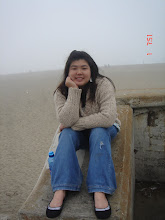 Golden Gate Bridge
Golden Gate BridgeThe Golden Gate Bridge is the symbolic of San Francisco city. Everybody who came here had to go to look at this bridge. If you did not to there it seems like you never came to San Francisco.
History of Golden Gate Bridge
Before the bridge
 Ocean tides flow through the Golden Gate four times a day -- twice coming in and twice going out. The quantity of salt water in motion between high and low tides averages 390 billion gallons.
Ocean tides flow through the Golden Gate four times a day -- twice coming in and twice going out. The quantity of salt water in motion between high and low tides averages 390 billion gallons.Water depth at the Golden Gate is more than 300 feet, but San Francisco Bay waters are, on average, just 14 feet deep.
San Francisco Bay is a drowned valley. At the end of the most recent Ice Age, 10,000 years ago, melting ice caused rising ocean levels. Water crept steadily through the Golden Gate and flooded the land beyond.
In October 1933, Civilian Conservation Corps workers arrived at Muir Woods National Monument, a protected old-growth redwood forest on the Marin headlands. They built revetments, bridges, buildings, benches, and an amphitheater -- anticipating a surge of new visitors to the majestic forest after the bridge opened.
During construction
 In August 1933, a Portland-bound ship, the Sidney M. Hauptman, veered off course in a dense fog and crashed into a construction trestle, setting back the project by about a month.
In August 1933, a Portland-bound ship, the Sidney M. Hauptman, veered off course in a dense fog and crashed into a construction trestle, setting back the project by about a month.Worker Albert "Frenchy" Gales was atop the unfinished south tower at the time of a June 1935 earthquake. He remembered, "the tower swayed 16 feet each way. There were 12 or 13 guys on top with no way to get down... The whole thing would sway toward the ocean, guys would say, 'here we go!' Then it would sway back toward the bay."
Days after a tragic accident that killed ten workers, searchers recovered the giant safety net that had also fallen from the bridge. Tides had carried it a mile out into the Pacific Ocean, and 500 feet beneath the surface. They found tangled in it the body of one of the victims, a carpenter named Arthur Anderson.
After Construction
 The bridge's original, two-tone fog horns functioned for almost half a century. In 1985, bridge officials replaced them with new air horns that only sound single tones.
The bridge's original, two-tone fog horns functioned for almost half a century. In 1985, bridge officials replaced them with new air horns that only sound single tones.The two main cables of the bridge weigh 11,000 tons apiece, and each main cable contains 25,572 separate wires.
The initial car toll in 1937 was 50 cents (a whopping $6.25 in 2002 dollars). By 2004, the car toll had risen to $5.00, or $4.00 with an electronic transponder -- but tolls are only collected from vehicles heading south into San Francisco.
The month of December has historically brought the most dangerous winds. Officials have closed the bridge only three times due to wind, in the Decembers of 1951 (69 mph winds), 1982 (70 mph winds), and 1983 (75 mph winds). None of the gusts caused structural damage.
The Golden Gate Bridge, completed after more than four years of construction at a cost of $35 million, is a visitor attraction recognized around the world. The GGB opened to vehicular traffic on May 28, 1937 at twelve o'clock noon, ahead of schedule and under budget, when President Franklin D. Roosevelt pressed a telegraph key in the White House announcing the event.
My Mapping




